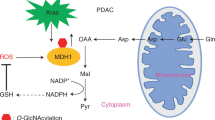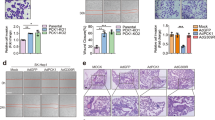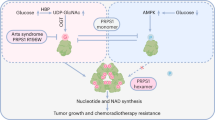Abstract
Aged hepatocyte-specific-Mcl-1 knockout (MKO-hep) mice are prone to develop liver tumors mimicking human hepatocellular carcinoma (HCC). Here we reported that a protein named UDP-N-acetylglucosamine pyrophosphorylase-1-like-1 (Uap1l1) is upregulated in the liver of young MKO-hep mice without any macroscopically detectable tumor nodules and is prominently expressed in the hepatic tumors developed in the aged MKO-hep mice. Intriguingly, human UAP1L1 is also significantly upregulated in a distinct subset of HCC tissues and patients with upregulated expression of UAP1L1 appeared to have poor prognosis. Overexpression of UAP1L1 significantly promoted, whereas UAP1L1 knockdown markedly reduced the proliferation of human hepatoma cells both in vitro and in vivo. UAP1L1 shows ~59% sequence identity to UDP-N-acetylglucosamine pyrophosphorylase-1 (UAP1), which is directly involved in the synthesis of the sugar donor (UDP-GlcNac) for N-acetylglucosamine modification (O-GlcNAcylation) of proteins. However, unlike UAP1, UAP1L1 harbors very limited UDP-GlcNAc synthesis activity. Moreover, although both UAP1 and UAP1L1 are required for O-GlcNAc transferase (OGT)-mediated protein O-GlcNAcylation, they appear to function distinctly from each other. UAP1L1 directly interacts with OGT, but does not seem to be an OGT substrate. In addition, UAP1L1 alone is not sufficient to activate OGT activity in vitro, suggesting that UAP1L1 may function together with other proteins to modulate OGT activity in vivo. Lastly, UAP1L1 knockdown attenuated c-MYC O-GlcNAcylation and protein stability, and overexpression of c-MYC significantly rescued the proliferation defect of UAP1L1 knockdown HepG2 cells, suggesting that c-MYC is one downstream target of UAP1L1 that contributes to UAP1L1-mediated cell proliferation, at least in HepG2 cells.
This is a preview of subscription content, access via your institution
Access options
Subscribe to this journal
Receive 50 print issues and online access
$259.00 per year
only $5.18 per issue
Buy this article
- Purchase on Springer Link
- Instant access to full article PDF
Prices may be subject to local taxes which are calculated during checkout








Similar content being viewed by others
References
Christiansen MN, Chik J, Lee L, Anugraham M, Abrahams JL, Packer NH. Cell surface protein glycosylation in cancer. Proteomics. 2014;14:525–46.
Cummings RD, Pierce JM. The challenge and promise of glycomics. Chem Biol. 2014;21:1–15.
Fuster MM, Esko JD. The sweet and sour of cancer: glycans as novel therapeutic targets. Nat Rev Cancer. 2005;5:526–42.
Lau KS, Dennis JW. N-Glycans in cancer progression. Glycobiology. 2008;18:750–60.
Liu FT, Rabinovich GA. Galectins as modulators of tumour progression. Nat Rev Cancer. 2005;5:29–41.
Butkinaree C, Park K, Hart GW. O-linked beta-N-acetylglucosamine (O-GlcNAc): extensive crosstalk with phosphorylation to regulate signaling and transcription in response to nutrients and stress. Biochim Biophys Acta. 2010;1800:96–106.
Capotosti F, Guernier S, Lammers F, Waridel P, Cai Y, Jin J, et al. O-GlcNAc transferase catalyzes site-specific proteolysis of HCF-1. Cell. 2011;144:376–88.
Hanover JA, Krause MW, Love DC. Bittersweet memories: linking metabolism to epigenetics through O-GlcNAcylation. Nat Rev Mol Cell Biol. 2012;13:312–21.
Stowell SR, Ju T, Cummings RD. Protein glycosylation in cancer. Annu Rev Pathol. 2015;10:473–510.
Wellen KE, Lu C, Mancuso A, Lemons JM, Ryczko M, Dennis JW, et al. The hexosamine biosynthetic pathway couples growth factor-induced glutamine uptake to glucose metabolism. Genes Dev. 2010;24:2784–99.
Wellen KE, Thompson CB. A two-way street: reciprocal regulation of metabolism and signalling. Nat Rev Mol Cell Biol. 2012;13:270–6.
Haltiwanger RS, Holt GD, Hart GW. Enzymatic addition of O-GlcNAc to nuclear and cytoplasmic proteins. Identification of a uridine diphospho-N-acetylglucosamine:peptide beta-N-acetylglucosaminyltransferase. J Biol Chem. 1990;265:2563–8.
Peneff C, Ferrari P, Charrier V, Taburet Y, Monnier C, Zamboni V, et al. Crystal structures of two human pyrophosphorylase isoforms in complexes with UDPGlc(Gal)NAc: role of the alternatively spliced insert in the enzyme oligomeric assembly and active site architecture. EMBO J. 2001;20:6191–202.
Hill VK, Ricketts C, Bieche I, Vacher S, Gentle D, Lewis C, et al. Genome-wide DNA methylation profiling of CpG islands in breast cancer identifies novel genes associated with tumorigenicity. Cancer Res. 2011;71:2988–99.
Hikita H, Takehara T, Shimizu S, Kodama T, Li W, Miyagi T, et al. Mcl-1 and Bcl-xL cooperatively maintain integrity of hepatocytes in developing and adult murine liver. Hepatol (Baltim, MD). 2009;50:1217–26.
Vick B, Weber A, Urbanik T, Maass T, Teufel A, Krammer PH, et al. Knockout of myeloid cell leukemia-1 induces liver damage and increases apoptosis susceptibility of murine hepatocytes. Hepatol (Baltim, Md). 2009;49:627–36.
Weng SY, Yang CY, Li CC, Sun TP, Tung SY, Yen JJ, et al. Synergism between p53 and Mcl-1 in protecting from hepatic injury, fibrosis and cancer. J Hepatol. 2011;54:685–94.
Weber A, Boger R, Vick B, Urbanik T, Haybaeck J, Zoller S, et al. Hepatocyte-specific deletion of the antiapoptotic protein myeloid cell leukemia-1 triggers proliferation and hepatocarcinogenesis in mice. Hepatology (Baltimore, MD). 2010;51:1226–36.
Cerami E, Gao J, Dogrusoz U, Gross BE, Sumer SO, Aksoy BA, et al. The cBio Cancer Genomics Portal: an open platform for exploring multidimensional cancer genomics data. Cancer Discov. 2012;2:401–4.
Gao J, Aksoy BA, Dogrusoz U, Dresdner G, Gross B, Sumer SO, et al. Integrative analysis of complex cancer genomics and clinical profiles using the cBioPortal. Sci Signal. 2013;6:pl1.
Roy A, Kucukural A, Zhang Y. I-TASSER: a unified platform for automated protein structure and function prediction. Nat Protoc. 2010;5:725–38.
Yang J, Yan R, Roy A, Xu D, Poisson J, Zhang Y. The I-TASSER Suite: protein structure and function prediction. Nat Methods. 2015;12:7–8.
Lazarus MB, Jiang J, Gloster TM, Zandberg WF, Whitworth GE, Vocadlo DJ, et al. Structural snapshots of the reaction coordinate for O-GlcNAc transferase. Nat Chem Biol. 2012;8:966–8.
Lazarus MB, Nam Y, Jiang J, Sliz P, Walker S. Structure of human O-GlcNAc transferase and its complex with a peptide substrate. Nature. 2011;469:564–7.
Shibata T, Aburatani H. Exploration of liver cancer genomes. Nat Rev Gastroenterol Hepatol. 2014;11:340–9.
Chou TY, Dang CV, Hart GW. Glycosylation of the c-Myc transactivation domain. Proc Natl Acad Sci USA. 1995;92:4417–21.
Chou TY, Hart GW, Dang CV. c-Myc is glycosylated at threonine 58, a known phosphorylation site and a mutational hot spot in lymphomas. J Biol Chem. 1995;270:18961–5.
Itkonen HM, Minner S, Guldvik IJ, Sandmann MJ, Tsourlakis MC, Berge V, et al. O-GlcNAc transferase integrates metabolic pathways to regulate the stability of c-MYC in human prostate cancer cells. Cancer Res. 2013;73:5277–87.
Cheung WD, Sakabe K, Housley MP, Dias WB, Hart GW. O-linked beta-N-acetylglucosaminyltransferase substrate specificity is regulated by myosin phosphatase targeting and other interacting proteins. J Biol Chem. 2008;283:33935–41.
Ruan HB, Han X, Li MD, Singh JP, Qian K, Azarhoush S, et al. O-GlcNAc transferase/host cell factor C1 complex regulates gluconeogenesis by modulating PGC-1alpha stability. Cell Metab. 2012;16:226–37.
Yang X, Qian K. Protein O-GlcNAcylation: emerging mechanisms and functions. Nat Rev Mol Cell Biol. 2017;18:452–65.
Postic C, Shiota M, Niswender KD, Jetton TL, Chen Y, Moates JM, et al. Dual roles for glucokinase in glucose homeostasis as determined by liver and pancreatic beta cell-specific gene knock-outs using Cre recombinase. J Biol Chem. 1999;274:305–15.
Chen Q, Yu X. OGT restrains the expansion of DNA damage signaling. Nucleic Acids Res. 2016;44:9266–78.
Nakajima K, Kitazume S, Angata T, Fujinawa R, Ohtsubo K, Miyoshi E, et al. Simultaneous determination of nucleotide sugars with ion-pair reversed-phase HPLC. Glycobiology. 2010;20:865–71.
Mio T, Yabe T, Arisawa M, Yamada-Okabe H. The eukaryotic UDP-N-acetylglucosamine pyrophosphorylases. Gene cloning, protein expression, and catalytic mechanism. J Biol Chem. 1998;273:14392–7.
Terasaka N, Kimura S, Osawa T, Numata T, Suzuki T. Biogenesis of 2-agmatinylcytidine catalyzed by the dual protein and RNA kinase TiaS. Nat Struct Mol Biol. 2011;18:1268–74.
Acknowledgements
We greatly appreciate the gift of mammalian OGT expression vectors from Dr Xiaochun Yu (Beckman Research Institute), the bacterial OGT expression vector from Dr Hsiu-Ming Shih (Academia Sinica), and various hepatoma cell lines from Dr Yuh-Shan Jou (Academia Sinica). We also thank Yi-Ning Chen at the Bioinformatics core at IMB for I-TASSER modeling and the Metabolomics Facilities of the Scientific Instrument Center at Academia Sinica for the analysis of the cellular levels of UDP-GlcNAc. This study was supported in part by an intramural fund from Academia Sinica and by grants (99-2320-B-001-009-MY3; 102-2320-B-001 -024 -MY3) from the National Science Council of Taiwan to H-FY-Y; funding to HL was provided by Chang Gung Memorial Hospital (CMRPG3D1512) and the Ministry of Education of Taiwan (EMRPD1E1581).
Author information
Authors and Affiliations
Corresponding author
Ethics declarations
Conflict of interest
The authors declare that they have no conflict of interest.
Electronic supplementary material
Rights and permissions
About this article
Cite this article
Lai, CY., Liu, H., Tin, K.X. et al. Identification of UAP1L1 as a critical factor for protein O-GlcNAcylation and cell proliferation in human hepatoma cells. Oncogene 38, 317–331 (2019). https://doi.org/10.1038/s41388-018-0442-6
Received:
Revised:
Accepted:
Published:
Issue Date:
DOI: https://doi.org/10.1038/s41388-018-0442-6
This article is cited by
-
Identification of UAP1L1 as a critical factor for prostate cancer and underlying molecular mechanism in tumorigenicity
Journal of Translational Medicine (2022)
-
O-GlcNAcylation links oncogenic signals and cancer epigenetics
Discover Oncology (2021)
-
Identification of novel locus associated with coronary artery aneurysms and validation of loci for susceptibility to Kawasaki disease
European Journal of Human Genetics (2021)



